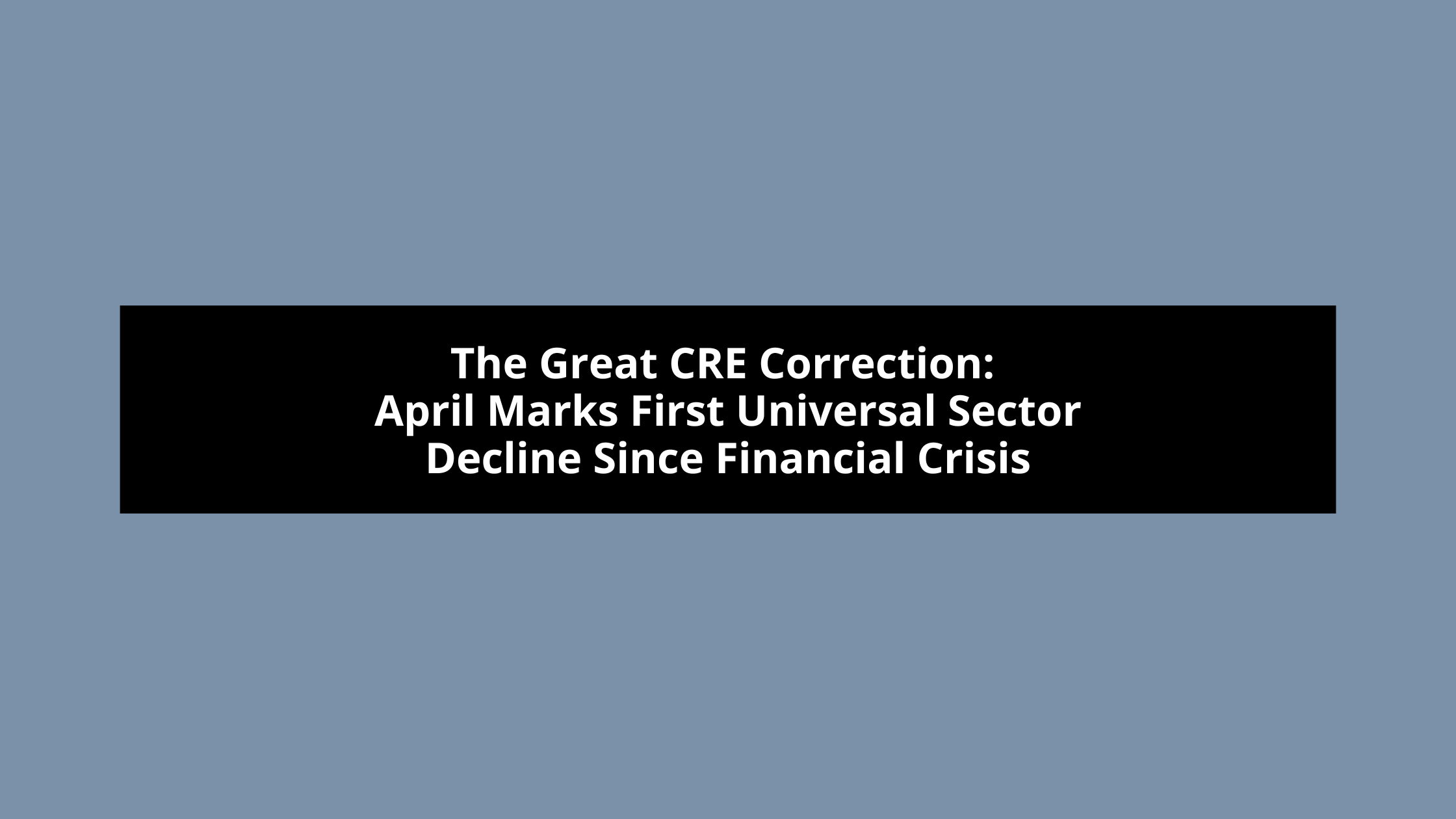Navigating Uncertainty While Spotting Opportunity
The commercial real estate market finds itself at an interesting crossroads in 2025, with transaction activity hitting a 12-month low even as underlying fundamentals show signs of stabilization.
While investors have largely adopted a wait-and-see approach amid economic and policy uncertainty, selective opportunities are emerging across sectors for those willing to look beyond the surface volatility.
Deal Activity Reflects Cautious Sentiment
CRE Market Update: March 2025 marked a notable slowdown in CRE transaction activity, with deal volume falling nearly 4% to reach its lowest monthly level in almost a year. This pullback wasn’t uniform across property types, however. Retail properties experienced the steepest decline at 40%, followed by office properties down over 11% and apartments declining nearly 10%. Despite this broad-based weakness, industrial properties bucked the trend with a robust 25% increase, while apartments maintained their position as the volume leader at $9.2 billion.
The investor sentiment data reveals the market’s cautious stance clearly. An overwhelming 70% of investors now recommend holding assets—a significant 14-point increase from previous quarters. Meanwhile, buy recommendations have fallen to just 23%, with only 7% favoring selling strategies. Interestingly, apartments stand out as the sole sector where buy recommendations exceed hold recommendations, driven by investor demand for stable cash flow in uncertain times.
Economic Backdrop Shapes Market Dynamics
The broader economic environment helps explain this cautious positioning. The US economy began 2025 with a minor GDP contraction, primarily attributed to pre-tariff import surges and reduced government spending. Despite this rocky start, economic forecasts remain relatively optimistic, with projected GDP growth of 1.3% for the full year, assuming no major policy disruptions.
Labor market conditions continue to provide some stability, with over 520,000 jobs added through April, though unemployment has edged up slightly to 4.2%. The Federal Reserve is anticipated to provide additional support through three expected rate cuts of 25 basis points each throughout 2025, which could ease financing conditions for commercial real estate transactions.
Sector Performance Reveals Mixed Signals
The industrial sector continues to demonstrate resilience, with leasing activity remaining strong in the first quarter, particularly among third-party logistics providers. However, potential tariff-induced cost pressures could moderate activity, especially for very large and small tenants. Markets along key trade corridors like the I-35, including Dallas and Kansas City, are positioned to benefit from ongoing trade diversification efforts.
Office markets showed surprising strength with an 18% quarter-over-quarter increase in leasing activity, led by New York and expanding across 32 of the 40 largest markets. Despite this positive momentum, occupiers are becoming more conservative, favoring lease renewals over expansions due to economic uncertainty.
Retail faced headwinds as availability crept up to 4.8% and absorption turned negative for the first time since late 2020. Evolving economic conditions, supply chain disruptions, and tighter consumer budgets are creating particular challenges for discount and big-box retailers, though low availability and limited new supply could support strategic leasing opportunities.
Construction and Capital Market Trends
Rising construction and financing costs have significantly impacted speculative development across all sectors. Industrial completions have fallen to their lowest levels since 2017, while office space under construction has declined 82% from 2020 levels. Retail deliveries hit a decade low at just 4.5 million square feet. This broad-based construction slowdown could ultimately support future rent growth as supply constraints tighten.
Despite transaction volume declines, capital markets showed encouraging signs with investment volume rising 14% year-over-year in the first quarter to $88 billion. CRE originations jumped an impressive 42% annually, driven largely by a 205% surge in office lending. Narrowing yield spreads and rising property prices for five consecutive quarters suggest a potential pricing floor may be forming.
Looking Forward with this CRE Market Update
While political and economic uncertainty continue to keep many CRE investors on the sidelines, emerging indicators suggest the market trough may be passing. CRE returns rose 40 basis points in the first quarter to reach a near three-year high, with retail leading at 1.8% returns, followed by apartments and industrial at 1.3% each.
The combination of strong investor appetite, resilient sector fundamentals, and selective opportunities in non-prime Class A offices, trade-aligned industrial corridors, well-anchored retail, and Midwest multifamily assets suggests that despite near-term challenges, the commercial real estate market is positioning for selective growth throughout 2025. For investors willing to navigate the current uncertainty, strategic opportunities await.
MylesTitle is an amazingly unique boutique real estate title insurance firm with a hand-picked, curated team of professionals.
Quarterbacked under the watchful eye of long-time industry pro Myles Lichtenberg, Esq. our team of paraprofessionals handle every aspect of your transaction with the precision of a finally tuned drill team. We interface with some of the globes top attorney’s, paraprofessionals, bankers, fund managers, developers, and highly skilled real estate authorities. They demand the very best, and our team answers the call!
More specifically, MylesTitle’s team provides Five-Star Service from initial intake through closing. No detail is left unattended to. Our Senior Team of professionals understands complex, high-value, and sometimes multi-state transactions, like no other.


